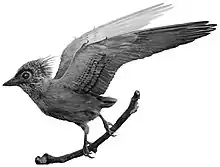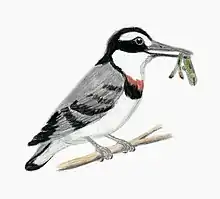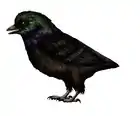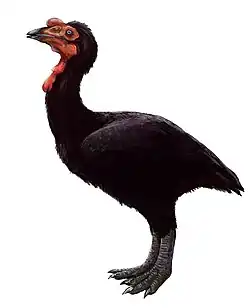Shanag
Shanag is a genus of dromaeosaurid theropod dinosaur from the Early Cretaceous Period of Mongolia.
| Shanag Temporal range: Early Cretaceous, | |
|---|---|
 | |
| Reconstructed Skull | |
| Scientific classification | |
| Domain: | Eukaryota |
| Kingdom: | Animalia |
| Phylum: | Chordata |
| Clade: | Dinosauria |
| Clade: | Saurischia |
| Clade: | Theropoda |
| Clade: | Eumaniraptora |
| Family: | †Dromaeosauridae |
| Genus: | †Shanag Turner et al., 2007 |
| Species: | †S. ashile |
| Binomial name | |
| †Shanag ashile Turner et al., 2007 | |
The type species of Shanag is S. ashile. It was named and described by Alan Turner, Sunny Hai-Ching Hwang and Mark Norell in 2007. The generic name refers to the black-hatted dancers in the Buddhist Cham dance. The specific name refers to the Ashile Formation, the old name for the layers where Shanag was found, used by Henry Fairfield Osborn.[1]
The holotype of Shanag, IGM 100/1119, was discovered in the Öösh Formation, the stratification of which is uncertain but probably dating to the Berriasian-Barremian. Shanag bears a strong resemblance to basal Chinese dromaeosaurids such as Microraptor and Sinornithosaurus, suggesting a close similarity between the fauna of the Öösh deposits, dated tentatively to 130 million years ago, and the Jehol Biota of China (such as the animals found in the roughly contemporary Yixian Formation), during the Early Cretaceous.[1]
Shanag was a small predator. In 2010 Gregory S. Paul estimated its length at 1.5 meters, the weight at five kilograms.[2] Shanag shows a mixture of dromaeosaurid, troodontid and basal avialan traits.[1]
Turner et al. assigned Shanag to the Dromaeosauridae. Their cladistic analysis indicated that it was a basal dromaeosaurid but higher in the tree than the Unenlagiinae.[1] Later analyses recovered it in the Microraptorinae.[3]
Morphology
The holotype specimen, about six centimeters long, is composed of an associated uncompressed upper and lower jaw fragment, containing a nearly complete right maxilla with teeth, a partial right dentary with teeth and an attached partial splenial.[1] The fossilized teeth in the specimen were pointed with serrations along the lengths of the posterior teeth, but no anterior teeth were available.[1] Shanag is autopomorphic as it lacks promaxillary fenestra and has interalveolar pneumatic cavities, which separates it from its nearest relative of S. millenii.[1] Its teeth have unusually long root lengths, making up about 70% of the overall tooth length.[1]
As part of the Theropoda group, Shanag had hollow bones and feathers. Though most were not capable of flight, some theropods used their feathers to assist in climbing or simply scrambling up tree trunks.[4] Feathers also allowed for thermoregulation by reducing the amount of airflow near the skin and preventing heat loss.[5] Their wings, though not capable of flight, could be used to stabilize themselves while on their prey via flapping like extant raptor birds.[6] Shanag are also believed to be endothermic based on their high speed and high level of activity.[4]
Family dromaeosaurida’s sharp middle toe (D-II) claws were initially thought to be for disemboweling prey, and then later tests suggested that due to the claw’s strength and cutting ability that they were used as a climbing tool for scaling the backs of prey larger than themselves.[7] This claim of scaling was later contested, and it was suggested the claws were used to grip and pin down prey similarly to extant birds of prey.[6]

See also
References
- Turner, A.S.; Hwang, S.H.; Norell, M.A. (2007). "A small derived theropod from Öösh, Early Cretaceous, Baykhangor Mongolia" (PDF). American Museum Novitates (3557): 1–27. doi:10.1206/0003-0082(2007)3557[1:ASDTFS]2.0.CO;2. Retrieved 2007-03-29.
- Paul, G.S., 2010, The Princeton Field Guide to Dinosaurs, Princeton University Press p. 133
- Longrich, N.R.; Currie, P.J. (2009). "A microraptorine (Dinosauria–Dromaeosauridae) from the Late Cretaceous of North America". PNAS. 106 (13): 5002–7. Bibcode:2009PNAS..106.5002L. doi:10.1073/pnas.0811664106. PMC 2664043. PMID 19289829.
- Sattler, Helen Roney; et al. (et. al) (1983). The Illustrated Dinosaur Dictionary. Illustrated by Pamela Carroll et al. Lothrop, Lee & Shepard Books.
- Schwab, R.; V., Schafer (1972). "Avian Thermoregulation and Its Significance in Starling Control". Vetebr Pest Conf Proc: 127–37.
- Fowler, Denver W.; Freedman, Elizabeth A.; Scannella, John B.; Kambic, Robert E. (2011-12-14). Farke, Andrew Allen (ed.). "The Predatory Ecology of Deinonychus and the Origin of Flapping in Birds". PLoS ONE. 6 (12): e28964. doi:10.1371/journal.pone.0028964. ISSN 1932-6203. PMC 3237572. PMID 22194962.
- Long, John A. (2008). Feathered dinosaurs : the origin of birds. Peter Schouten. Oxford: Oxford University Press. ISBN 978-0-19-537266-3. OCLC 190843466.
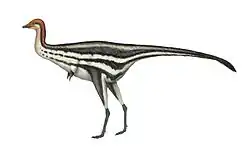
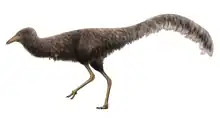


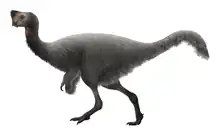
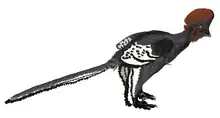


.png.webp)


.jpg.webp)
